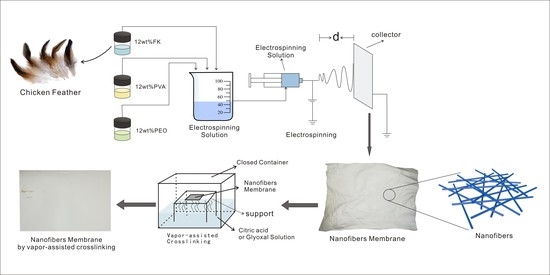Vapor-Assisted Crosslinking of a FK/PVA/PEO Nanofiber Membrane
Abstract
:1. Introduction
2. Materials and Methods
2.1. FK Extraction
2.2. Electrospinning of the FK/PVA/PEO Nanofiber Membrane
2.3. Vapor-Assisted Crosslinking of the FK/PVA/PEO Nanofiber Membrane
2.4. Characterization
3. Results
3.1. Microstructural Analysis
3.2. Structural Analysis
3.3. Thermal Analysis
3.4. Hydrophobicity Analysis
3.5. Mechanical Characterization
4. Conclusions
Author Contributions
Funding
Acknowledgments
Conflicts of Interest
References
- Dou, Y.; Zhang, B.N.; He, M.; Yin, G.Q.; Cui, Y.D.; Savina, I.N. Keratin/Polyvinyl Alcohol Blend Films Cross-Linked by Dialdehyde Starch and Their Potential Application for Drug Release. Polymers 2015, 7, 580–591. [Google Scholar] [CrossRef] [Green Version]
- Shavandi, A.; Silva, T.H.; Bekhit, A.A.; Bekhit, A.E.D.A. Dissolution, Extraction and Biomedical Application of Keratin: Methods and Factors Affecting the Extraction and Physicochemical Properties of Keratin. Biomater. Sci. 2017, 5, 1699–1735. [Google Scholar] [CrossRef] [PubMed]
- Ma, B.; Qiao, X.; Hou, X.; Yang, Y. Pure keratin membrane and fibers from chicken feather. Int. J. Biol. Macromol. 2016, 89, 614–621. [Google Scholar] [CrossRef] [PubMed] [Green Version]
- Didaskalou, C.; Buyuktiryaki, S.; Kecili, R.; Fonte, C.P.; Szekely, G. Valorisation of agricultural waste with adsorption/nanofiltration hybrid process: From materials to sustainable process design. Green Chem. 2017, 19, 3116–3125. [Google Scholar] [CrossRef]
- Cucina, M.; Zadra, C.Z.; Marcotullio, M.C.; Maria, F.D.; Sordi, S.; Curini, M.; Gigliotti, G. Recovery of energy and plant nutrients from a pharmaceutical organic waste derived from a fermentative biomass: Integration of anaerobic digestion and composting. J. Environ. Chem. Eng. 2017, 5, 3051–3057. [Google Scholar] [CrossRef]
- Sekar, M.P.; Roopmani, P.; Krishnan, U.M. Development of a novel porous polyvinyl formal (PVF) microfibrous scaffold for nerve tissue engineering. Polymer 2018, 142, 170–182. [Google Scholar] [CrossRef]
- Min, B.M.; Lee, G.; Kim, S.H.; Nam, Y.S.; Lee, T.S.; Park, W.H. Electrospinning of silk fibroin nanofibers and its effect on the adhesion and spreading of normal human keratinocytes and fibroblasts in vitro. Biomaterials 2004, 25, 1289–1297. [Google Scholar] [CrossRef] [PubMed]
- Cho, D.; Nnadi, O.; Netravali, A.; Yong, L.J. Electrospun Hybrid Soy Protein/PVA Fibers. Macromol. Mater. Eng. 2010, 295, 763–773. [Google Scholar] [CrossRef]
- Jin, H.J.; Fridrikh, S.V.; Rutledge, G.C.; Kaplan, D.L. Electrospinning Bombyx mori silk with poly(ethylene oxide). Biomacromolecules 2002, 3, 1233–1239. [Google Scholar] [CrossRef] [PubMed]
- Valtcheva, I.B.; Marchetti, P.; Livingston, A.G. Crosslinked polybenzimidazole membranes for organic solvent nanofiltration (OSN): Analysis of crosslinking reaction mechanism and effects of reaction parameters. J. Membr. Sci. 2015, 493, 568–579. [Google Scholar] [CrossRef]
- Fei, F.; Cseri, L.; Szekely, G.; Blanford, C.F. Robust Covalently Crosslinked Polybenzimidazole/Graphene Oxide Membranes for High-Flux Organic Solvent Nanofiltration. ACS Appl. Mater. Interfaces 2018, 10, 16140–16147. [Google Scholar] [CrossRef] [PubMed]
- Park, M.; Shin, H.K.; Panthi, G.; Rabbani, M.M.; Alam, A.M.; Choi, J.; Chung, H.J.; Hong, S.T.; Kim, H.Y. Novel preparation and characterization of human hair-based nanofibers using electrospinning process. Int. J. Biol. Macromol. 2015, 76, 45–48. [Google Scholar] [CrossRef] [PubMed]
- Zhang, X.; Tang, K.; Zheng, X. Electrospinning and Crosslinking of COL/PVA Nanofiber-microsphere Containing Salicylic Acid for Drug Delivery. J. Bionic Eng. 2016, 13, 143–149. [Google Scholar] [CrossRef]
- Reddy, N.; Yang, Y. Citric acid cross-linking of starch films. Food Chem. 2010, 118, 702–711. [Google Scholar] [CrossRef] [Green Version]
- Wang, H.Y. Studies on Properties and Application of Feather Keratin/Sodium Carboxy Methyl Cellulose Blend Film; Zhongkai University of Agriculture and Engineering: Guangzhou, China, 2014. [Google Scholar]
- He, M.; Zhang, B.; Dou, Y.; Yin, G.; Cui, Y. Blend modification of feather keratin-based films using sodium alginate. J. Appl. Polym. Sci. 2017, 134. [Google Scholar] [CrossRef]
- He, M.; Zhang, B.; Dou, Y.; Yin, G.; Cui, Y.; Chen, X. Fabrication and characterization of electrospun feather keratin/poly(vinyl alcohol) composite nanofibers. RSC Adv. 2017, 7, 9854–9861. [Google Scholar] [CrossRef] [Green Version]
- Zhu, Y.H.; Wang, W.Y.; Jin, X.; Zhou, C.; Xu, J.Y.; Xiao, C.F.; Lin, T. Studies on the crosslinking of electrospun starch nanofibers. J. Funct. Mater. 2015, 46, 5048–5051. [Google Scholar]
- Choi, J.; Panthi, G.; Liu, Y.; Kim, J.; Chae, S.H.; Lee, C.; Park, M.; Kim, H.Y. Keratin/poly (vinyl alcohol) blended nanofibers with high optical transmittance. Polymer 2015, 58, 146–152. [Google Scholar] [CrossRef]
- Liu, Y.; Zhai, P.Y.; Lei, T.D.; Wang, Y.H.; Cao, F.Y.; Fan, J. Fabrication and properties of high-content keratin/poly(ethylene oxide) blend nanofibers. J. Tianjin Polytech. Univ. 2016, 35, 1–7. [Google Scholar]
- Li, S.; Yang, X.H. Fabrication and Characterization of Electrospun Wool Keratin/Poly(vinyl alcohol) Blend Nanofibers. Adv. Mater. Sci. Eng. 2014, 2014, 1–7. [Google Scholar] [CrossRef]
- Fan, J.; Lei, T.D.; Li, J.; Zhai, P.Y.; Wang, Y.H.; Cao, F.Y.; Liu, Y. High protein content keratin/poly(ethylene oxide) nanofibers crosslinked in oxygen atmosphere and its cell culture. Mater. Des. 2016, 104, 60–67. [Google Scholar] [CrossRef]
- Guan, M.; Xie, J.; Xue, B.; Jiang, H.Y.; Shao, Z.H.; Sun, T. Effect of sodium citrate on properties of chitosan/soybean protein isolate composite films. Sci. Technol. Food Ind. 2016, 37, 277–280. [Google Scholar]
- Li, J.; Lei, T.D.; Wang, Y.H.; Cao, F.Y.; Liu, Y.; Fan, J. Preparation and Characterization of High-Content Keratin/PEO Nanofiber Using Organic Solvent. J. Donghua Univ. 2016, 42, 793–799. [Google Scholar]
- Liu, Y.; Yu, X.; Li, J.; Fan, J.; Wang, M.; Lei, T.D.; Liu, J.; Huang, D. Fabrication and properties of high-content keratin/poly(ethylene oxide) blend nanofibers using two-step cross-linking process. J. Nanomater. 2015, 2015, 10. [Google Scholar] [CrossRef]
- Spei, M.; Holzem, R. Thermoanalytical investigations of extended and annealed keratins. Colloid Polym. Sci. 1987, 265, 965–970. [Google Scholar] [CrossRef]
- Liu, Y.; Li, J.; Fan, J.; Wang, M. Preparation and Characterization of Electrospun Human Hair Keratin/Poly(ethylene oxide) Composite Nanofibers. Rev. Mater. 2014, 19, 382–388. [Google Scholar]
- Chen, Q.; Lu, W.J.; Zhang, W.Q.; Deng, X.; Jin, X.R. Effect of Aldehydes on the Properties of the Composite Chitosan Films. J. East China Univ. Sci. Technol. 2005, 31, 398–402. [Google Scholar]
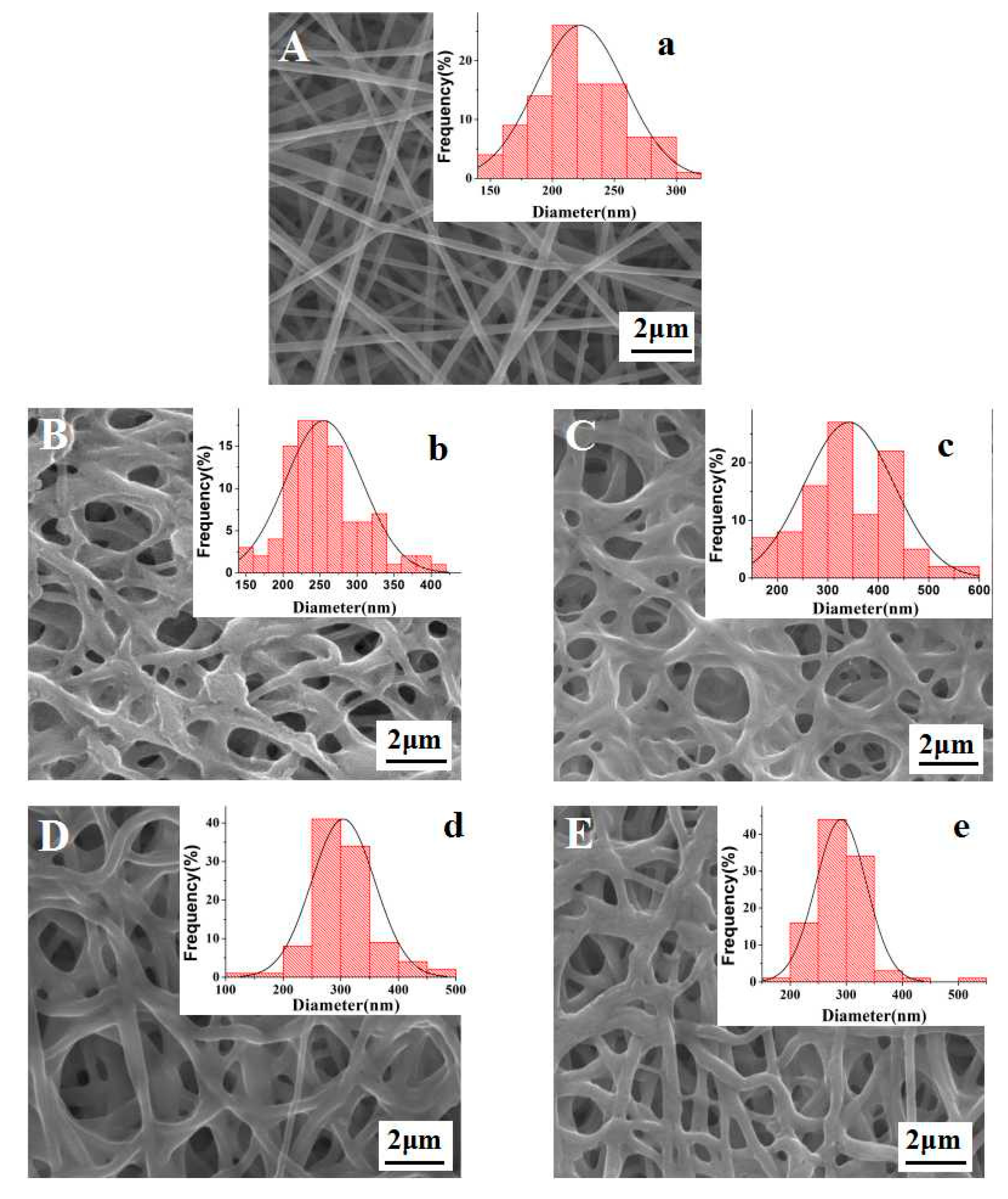
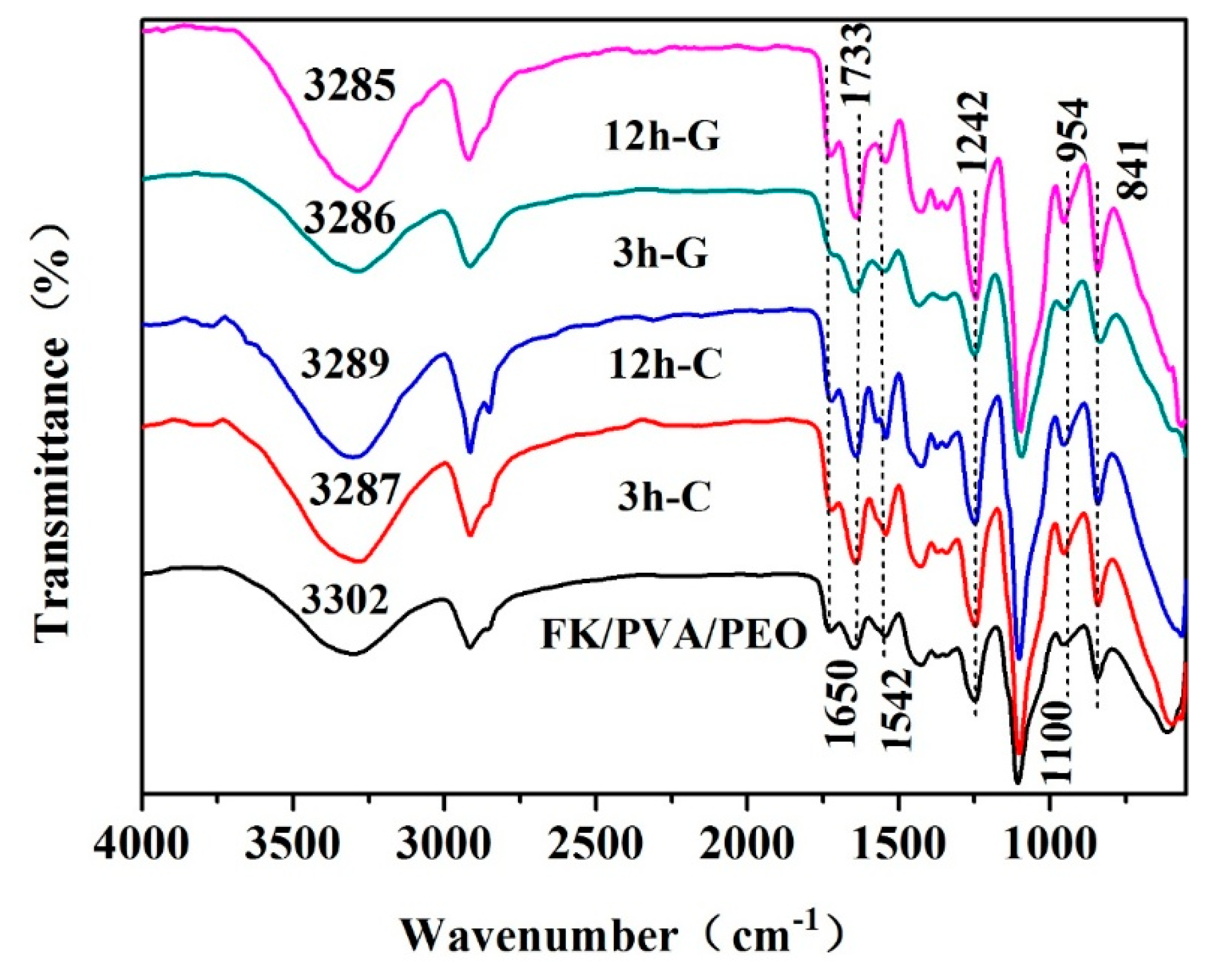

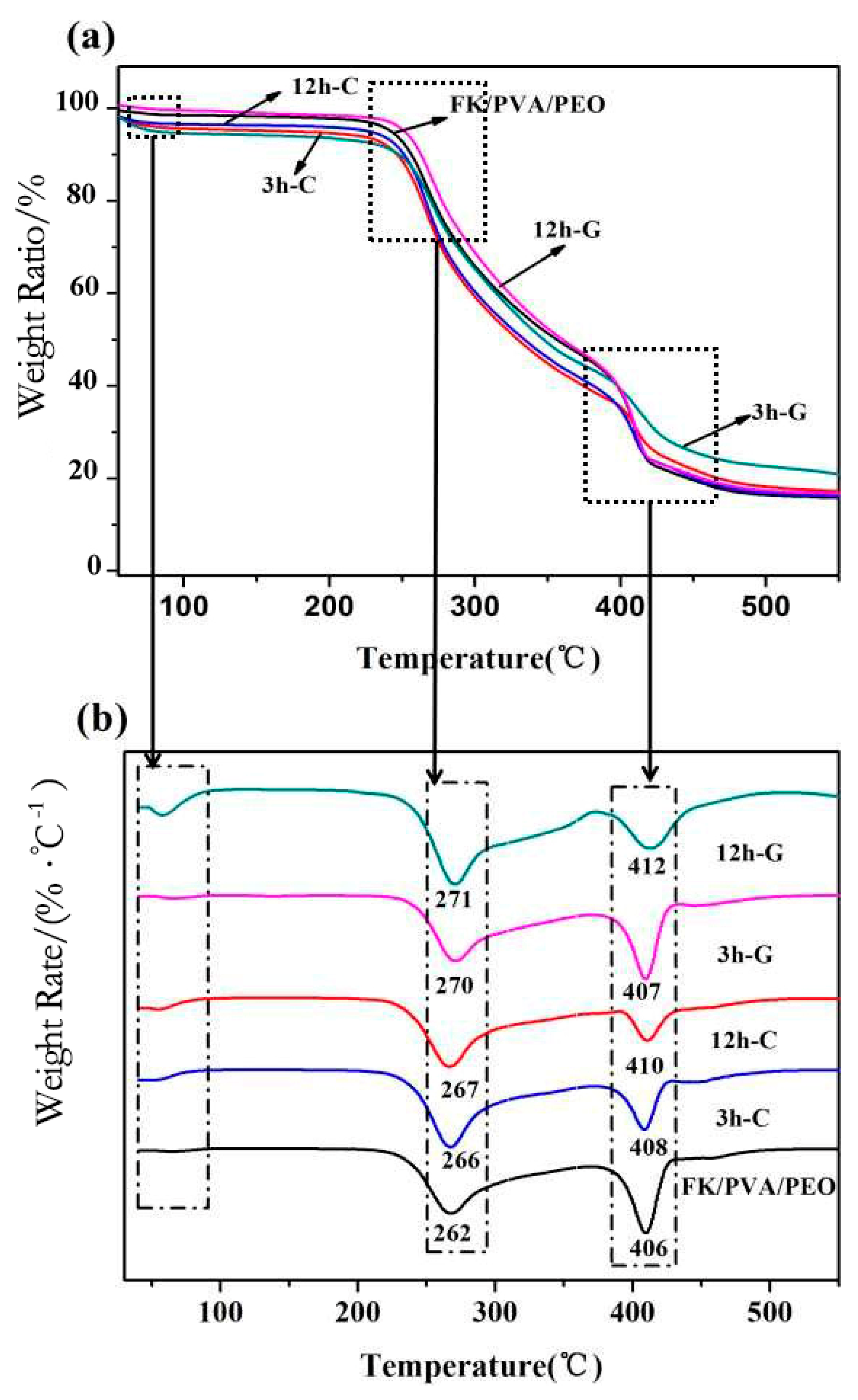
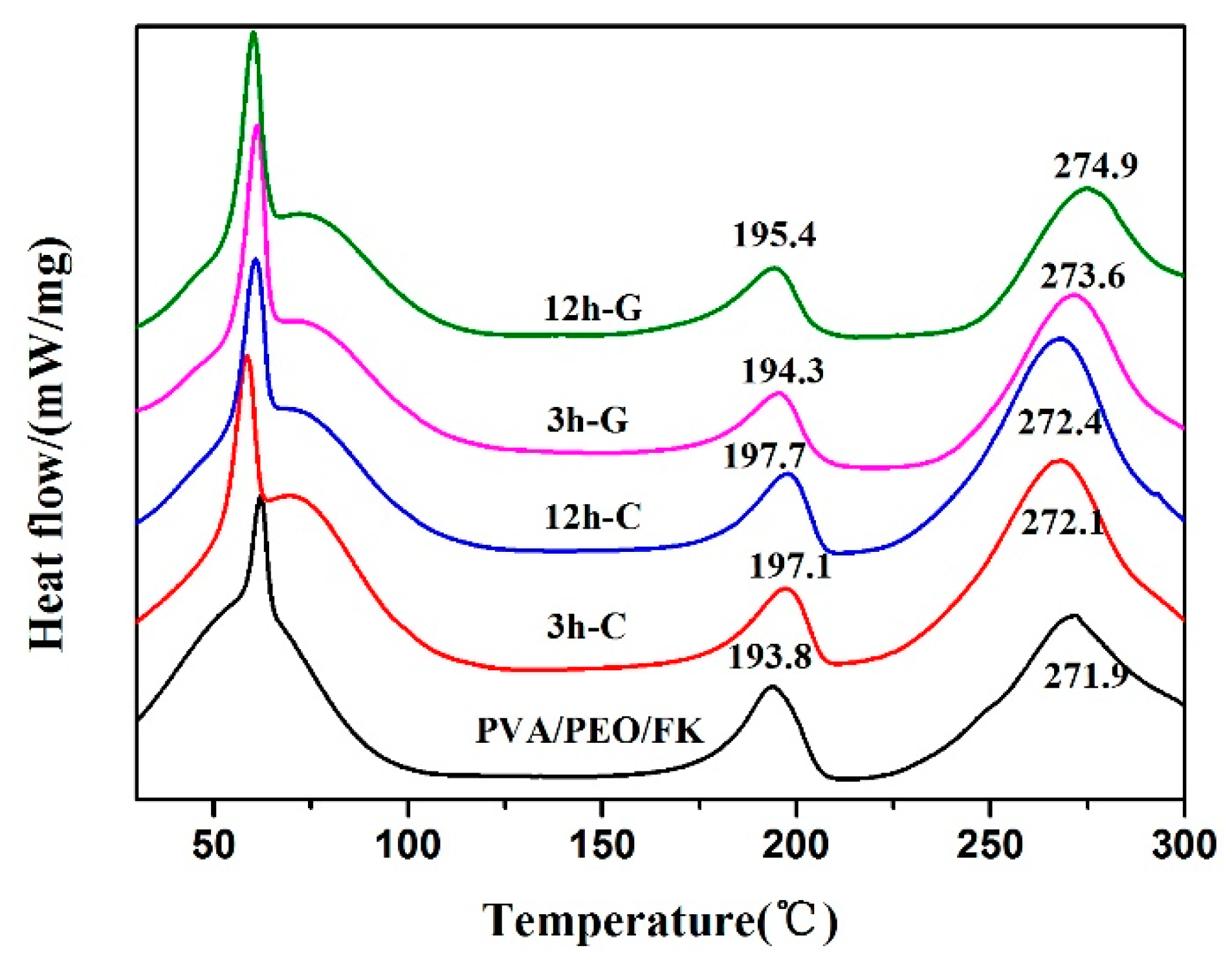
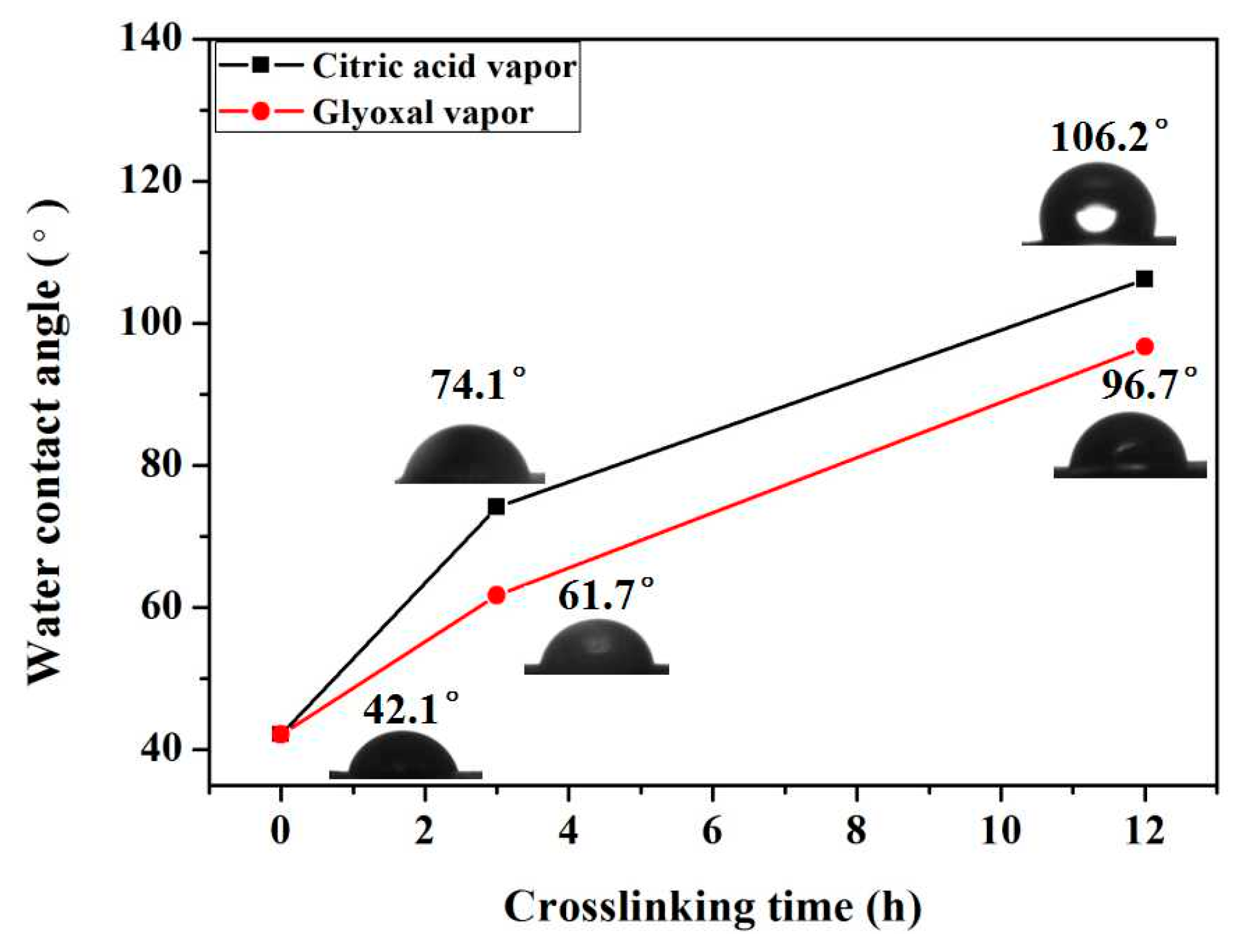

| FK/PVA/PEO Membrane | Average Diameter (nm) |
|---|---|
| without treatment | 223 ± 36 |
| 3h-C | 255 ± 52 |
| 12h-C | 342 ± 58 |
| 3h-G | 291 ± 45 |
| 12h-G | 304 ± 55 |
| Name Grade/Purity | Supplier |
|---|---|
| Chicken feathers | Waste Market |
| Peracetic acid Analytical reagent (AR) | Tianjin Fuchen Chemical Reagents Factory |
| PVA Degree of alcoholysis: 87–89% | Shanghai Aladdin Biochemical Polytron Technologies Inc. |
| PEO Molecular weight: 400,000 Da | Shanghai Aladdin Biochemical Polytron Technologies Inc. |
| Citric acid Analytical reagent (AR) | Tianjin Fuchen Chemical Reagents Factory |
| Glyoxal solution 40 wt % | Shanghai Aladdin Biochemical Polytron Technologies Inc. |
© 2018 by the authors. Licensee MDPI, Basel, Switzerland. This article is an open access article distributed under the terms and conditions of the Creative Commons Attribution (CC BY) license (http://creativecommons.org/licenses/by/4.0/).
Share and Cite
Ding, J.; Chen, M.; Chen, W.; He, M.; Zhou, X.; Yin, G. Vapor-Assisted Crosslinking of a FK/PVA/PEO Nanofiber Membrane. Polymers 2018, 10, 747. https://doi.org/10.3390/polym10070747
Ding J, Chen M, Chen W, He M, Zhou X, Yin G. Vapor-Assisted Crosslinking of a FK/PVA/PEO Nanofiber Membrane. Polymers. 2018; 10(7):747. https://doi.org/10.3390/polym10070747
Chicago/Turabian StyleDing, Jiao, Man Chen, Wenjie Chen, Ming He, Xiangyang Zhou, and Guoqiang Yin. 2018. "Vapor-Assisted Crosslinking of a FK/PVA/PEO Nanofiber Membrane" Polymers 10, no. 7: 747. https://doi.org/10.3390/polym10070747



